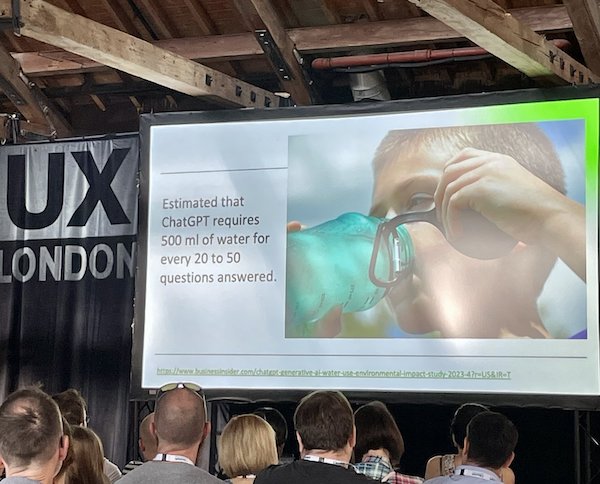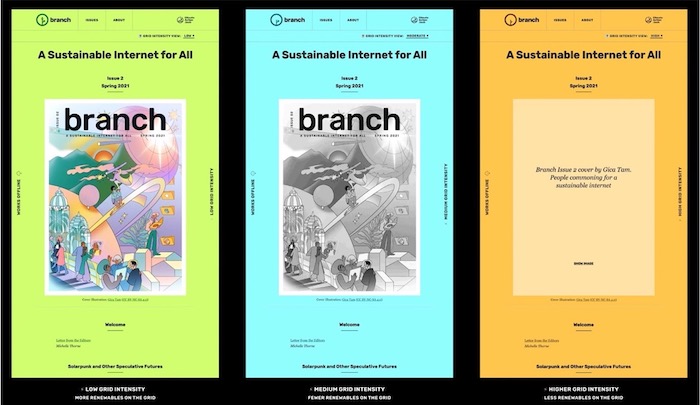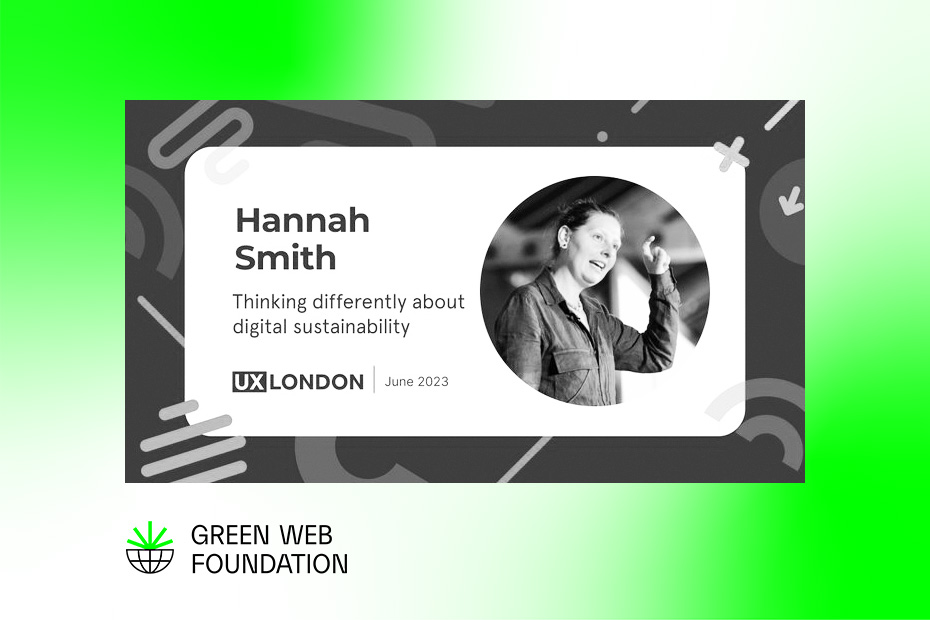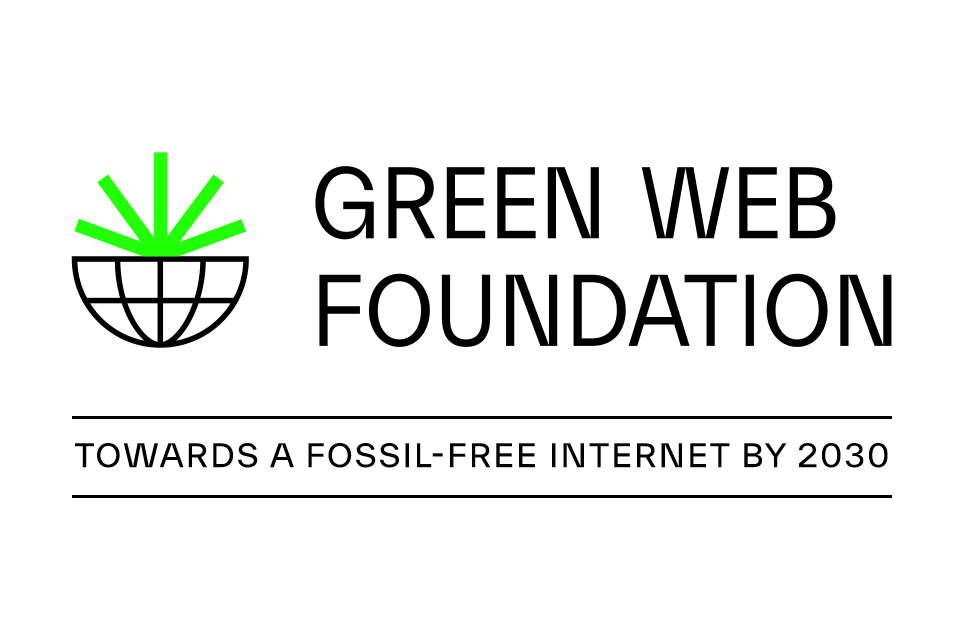It was a real honour for me to invited to speak at UX London 2023 and represent our work at Green Web Foundation (GWF). The conference has been running for about ten years and, as you guessed it, has a focus on UX issues. Clearleft, the organisers, pitch it as “covering all aspects of the design process from user research and interaction design through to product design and design systems”. It’s widely regarded as the UX event to attend in the UK.
Aside from speaking and advocating for a fossil-free internet to a digitally-focused audience, I was keen to broaden my own horizons. From my permaculture practice, I’m always mindful of the fact that the edges and overlaps, or as sometimes people call them the intersections, are typically where we have the most to learn.
My intention for heading to UX London was therefore: to share our work at GWF and talk about a fossil-free internet, to be open to learning, to hearing different voices, making new connections and above all to listen and reflect on my own practices.
My talk
I gave a 30 min talk titled Thinking Differently about Digital Sustainability. My intention was to break the mould of what is widely expected from a talk about digital sustainability these days (software/website performance and optimization) and present a broader, more holistic view of the issues. In particular, I felt that the UX London audience would be receptive to a presentation about the mindset shifts required to change our systems, rather than a bunch of checklists.
Talk synopsis
Digital is often regarded as green or sustainable by default. But it’s not. The truth is that whilst digital is usually much less impactful than offering a real-life alternative, it is not without significant downsides.
In this talk, we’ll discuss how digital isn’t sustainable and what mindset shifts we need to get to a sustainable, fossil-free tech industry.
Main feedback
There were two points I made during the talk that seemed to resonate most strongly with the audience.
Water usage by ChatGPT
“It’s estimated that ChatGPT requires 500 ml of water for every 20 to 50 questions answered.”

The carbon emissions arising from tech’s electricity use is what most people focus on when considering the environmental impact from the industry. But there are also other impacts to think about, and water is one of them. ChatGPT is such a hot topic that it makes it a great example to get this point across.
It’s not just ChatGPT that uses water, it’s all data centers. If you want to learn more about this issue, check out this post by David Mytton, How much water do data centers use? You can also read up on the article which I drew the quote from.
Carbon aware software
I spoke about green software and the notion that in the future we might see software that responds to the electricity available on the grid. For example where there are periods of renewables, and energy is cleaner, we might do more with our software. When renewables aren’t abundant and we’re using lots of fossil fuels (high carbon intensity), we might offer a paired back experience to users.
I used the example of analytics. How might analytics present themselves differently depending on different conditions on the grid? For UX designers there might be some interesting design challenges around what you choose not to display, or allow users to do, when carbon intensity is high. How do we manage the expectations of users?

During the talk I should have demonstrated our Branch magazine. But due to time constraints I missed it out. Was a bit silly really. For future I will definitely include Branch for design audiences, even if I have to remove something else from the talk. Anyway, Branch magazine demonstrates this idea by talking to the UK’s electricity grid and depending on the carbon intensity at that moment shows a different website design. Mainly it treats images differently. On dirty days (the orange view above), the images only load when the users clicks to see them, they don’t load by default. On medium dirty days (the blue view above) you see the images, but they are a lesser degree of quality. On the cleanest of days (the green view) you see all the images.
Learning from the other talks
Thankfully I was the second speaker on the agenda, so I had the headspace to really engage with all the other talks. The agenda was very well curated – I loved every talk I heard! Kudos to Jeremy Keith and the rest of the Clearleft team.
Every talk gave me an insight into my own work on sustainability and challenges we face as a small non-profit building and advocating for digital sustainability solutions. Here’s some of my reflections from each talk and ideas that bubbled up as a result.
Vimla Appadoo – Designing your Design process
Vim had the tough task of opening the whole event but set the standard sky high. She opened her talk with vulnerability about herself. She’s a new mum returning to work and was feeling nervy. She asked the audience to be kind and supportive.
I loved the courage and strength of that opening. In sustainability circles, it’s really important we are in touch with our feelings and address them, especially if we want to sustain our presence on the field. I loved that Vim normalized this straight away at the conference.
Resonating points from the talk:
- “Culture fit” not such a good term to use, and instead think about “culture add”.
- Diversity is hard, and a truly diverse team needs to know how to deal with differences in opinions and embrace those.
- Understand your own values. Understand your team’s values. Only then can you start to build that into the business values.
Imran Afzal – Let’s choose empathy
Imran’s talk definitely resonated with me. We’d already discussed the topic at the speaker’s dinner the evening before. I’ve always felt that lack of empathy for fellow living beings (humans, plants, animals and ecosystems) is a root cause for the multiple crises we find ourselves in globally – climate change, biodiversity loss etc.
Resonating points from the talk:
- The promise of the UX community to the tech world – “listening is the promise we brought to the tech world”.
- Deep listening and building a listening sensor. The first step of that is to clear your mind of all distractions so you are ready to receive.
- Book by Indi Young, “It’s time to listen”.
- Empathy is a choice that leads to change.
Later I found myself thinking about finding solutions for sustainability issues – solutions that mean real impact. This should involve spending a lot of time listening and observing those affected. Knee jerk solutions rarely help anyone. Plus jumping in without empathy for those who’ve been tackling these problems ahead of you is one of the first mistakes so many people make, especially in the tech sector.
Stephen Hay – The lies we tell ourselves about design systems
I wasn’t actually sure how much I’d get from Stephen‘s talk. I’m not a designer. I’ve never worked with design systems. I know what they are, but from a theoretical point of view. But I realised somes systems I know more about than just theory, are ecosystems and system change. They’re some hella complex system to exist within.
Resonating points from the talk:
- All the lies that Stephen spoke about hold some truth for me for work in designing and building software. Specifically lies:
- #1 Most design systems are glorified component libraries. Components become interesting when they interact with environments.
- #2 Documentation is optional.
- #3 Design systems should predict the future.
- #6 Having choice removes the need for thought.
- “Beauty emerges from selection, affinities, choice and love”.
The last part about beauty got me thinking about my work in sustainability. Somewhere deep down I’m pretty sure I work on sustainability because I want to live in a beautiful world. But sometimes that desire for beauty can be lost amongst the need to get things done quickly, or to be practical. As an aside I bumped into Chris How who I met when I was speaking at Pixel Pioneers in 2022, who gave a great talk then “You got to right for the right to delight“. Both reminded me that I need to find more time for beauty in my day to day.
Stephen and I also spent a lot of time chatting at the speaker’s dinner and during the first day of the conference. One of my favourite things that we chatted about, along with Jeremy Keith, was the idea for another talk about extreme design constraints.
One of the points I made in my own talk was “what is the acceptable upper limit for resource use by tech?”. We’ve become lazy in tech and we do so much because we can, rather than because we should, or because it actually really helps anyone. A talk showing the kind of awesome creativity that happens when you do impose limits on things would be pretty inspiring. Jeremy talked about the early days of the internet when he would receive music compositions in ASCII text.
Another thing I enjoyed talking about with Stephen was horseshoe politics.
David Dylan Thomas – What if people weren’t the product? Building a web that loves humanity
I was pretty sure that David‘s talk would be the highlight of the conference for me and it certainly was! Literally every single thing he said resonated with me, but I’ll try and narrow it down to a few bullet points (hard!).
Resonating points from the talk:
- We must rapidly transition from an “object-orientated” to a “people-orientated” society.
- Capitalism sucks, not his precise words, but definitely that sentiment.
- Mirrors have changed the way we see ourselves and the internet has become a big, personalised, giant mirror.
- The more a post is engaged with the more likely it is to have misinformation.
- His words precisely “No seriously, fuck engagement”.
- Native American Blackfoots wisdom has a system of measuring prosperity by how generous you are.
- Kandiaronk, a famous leader and orator in Native America, was the lead not because of birth or wealth, but because he was able to lead.
- Just-world hypothesis – people don’t get what they deserve.
- What are the things your company is willing to leave money on the table for?
- We’ve built a web that is indifferent to humanity.
- What if engagement was the number of people who got help, not the clicks and the likes.
Highly recommend David’s book “Design for Cognitive Bias” as well.
Mansi Gupta – The necessity and practice of women-centric design
Having looked through the #UXLondon posts on LinkedIn, I’m pretty sure that Mansi‘s talk was one of the most popular of the whole conference. And for good reason. It was packed full of practical insights, useful to 100% of people in that room.
From my perspective, I was looking forward to this as in sustainability circles there is much cited research that solving gender inequality issues is a root issue for solving the biggest sustainability issues too.
Resonating points from the talk:
- Designing for ‘everyone’ = one-size-fits-men outcomes.
- Her four part women-centric eye model:
- w-offensive = inappropriately targetting women.
- w-impartial – unintended consequences created by “gender-neutral” design.
- w-informed – women as majority / largest consumer.
- w-holistic – solutions that not only serve, not only value, but deserve women.
- Ensuring women are not internalising a broken system as a lack in their own self-confidence.
Mansi and I also had quite a bit of time to chat after her talk, and she invited me to use her four part model and apply it to the sustainability work I do. I’m definitely up for seeing how it applies, and collaborating with Mansi on it.
Paul Robert Lloyd – Time team: Documenting decisions and marking milestones
I was looking forward to Paul‘s talk. I often feel like I’m waving the documentation banner in our own team. On stage, I also talked about the importance of organisations publishing their own research and work on sustainability, so I felt I could learn a thing or two from Paul.
Resonating points from the talk:
- Documentation can also be called “design history”.
- A design history is public, but not written for the public (it’s for the team).
- Documentation is an act of professionalism.
- Develop a culture, not a cult.
- We shape our tools, then our tools shape us.
- Stickers and badges become tokens that represent something more – a shared experience, a moment in history.
- Nasa Mission badges.
Stacey Mendez – User experience beyond screens
Before Stacey took to the stage, the idea of her talk already got me thinking about overlaps into the world of sustainability. Particularly a trait I’ve seen amongst developers. So often for devs, the first reaction when first learning about the severity of the climate crisis is to build an app to solve it. This approach sadly misses the point. An app alone isn’t going to make the world more sustainable (tech solutionism anyone?). It’s actions in the real world that make the difference, the experiences we have outside of our screens.
Resonating points from the talk:
- The future of UX is not digital, it’s broader.
- Things that stop us designing wider: silos, different tools, different timescales, language/terminology, conducting only singular testing (not end to end).
- What is the actual quality and value for a user/human.
Daniel Burka – Can designers save lives? Not by themselves
Daniel talked about his purpose to work on something that mattered – designing better public health care experiences. His talk synopsis said “public health programs affecting millions of patients in places like India, Bangladesh, Sri Lanka, Ethiopia, and Nigeria are largely untouched by professional designers”.
It resonated with me. I’ve recently had something that Rachel Coldicott, ED of Promising Trouble said on my mind a lot “What if we already have all the technology we need? And the biggest challenge for innovation isn’t making more stuff… But equitably distributing the technologies we already have?“. In fact this quote has been on my mind so much I wove it into my own talk.
Resonating points from the talk:
- Avoid saying no to new ideas too often. Prototype to demonstrate why an idea is problematic.
- Break down the walls – bring stakeholders together to design solutions.
- Co-create with real users.
- The ecosystem of wicked problems by Christian Sarkar and Philip Kotler.
Asia Hoe – Ghosts in the machine: AI, design, and ethics
I was gutted to miss this talk from Asia, but unfortunately I had to leave before the end of the conference. The Clearleft team told me they would record Asia’s talk and send it across, so when I’ve had chance to catch up (and catch up I will, this topic is SO important right now) I’ll update this post with some thoughts.
Rounding off
Overall my experience at UX London was top notch – both as a speaker and an attendee. I see why the event is held in such high regard – it was a truly mind opening couple of days, and I didn’t even get chance to write up the workshops that also took place! Thanks for giving us the chance to talk about how we get to a fossil-free internet UX London!



